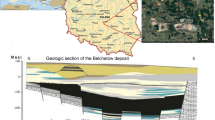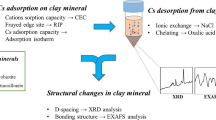Abstract
This study investigates the complexes formed between amino acids, which are the natural degradation products of organic matter, and smectites. Thus, the adsorption and desorption behavior of cysteine and Na-, Ca-, Cu-homoionic smectites with different layer-charge location, a montmorillonite, and a beidellite, were studied. The clay samples were treated with Na, Ca, and Cu 1 N solutions and then with a 0.2 M cysteine solution. To test smectite-cysteine stability at acidic pH, the solids obtained were repeatedly treated with distilled water acidified to pH = 5. All treated samples were characterized by thermal, X-ray diffraction, chemical, and infrared analyses. The results showed that: 1) Na- and Ca-rich smectites adsorbed and retained small amounts of cysteine, and did not show interlayer cation-cysteine complexes, whereas the amino acid was strongly retained in the interlayer by Cu-rich smectites; 2) d(001)-values for Na- and Ca-rich smectites showed little or no expansion, whereas for the Cu-rich smectites the intercalation of the organic molecule produced a swelling of the structure; 3) the interaction mechanism of homoionic smectites with cysteine in an aqueous medium occurs by weak interactions, (e.g., van der Waals interactions, hydrogen bonding, dipole-dipole interactions, and other electrostatic forces such as entropy-driven hydrophobic bonding), and/or by complexes involving interlayer cations and organic ligands. The formation of a stable chelate complex with the saturating ion permits cysteine to be adsorbed by Cu(II)-rich smectites and to be resistant to migration in soils and groundwaters.
Similar content being viewed by others
References
Aizawa, S., Okamoto, K., Einaga, H., and Hidaka, J. (1988) S-bridget poly nuclear complexes. II. Formationand some properties of [M Co (L-Cys-N, S)32]-type complexes (M = Fe(III), Co(III), and Ni(II); L-Cys = L-Cysteinate). Bulletin of the Chemical Society of Japan, 61, 1601–1606.
Barrett, G.C. (1985) Chemistry and Biochemistry of the Amino Acids. G.C. Barrett, ed. Chapman and Hall, London, 684 pp.
Bellamy, L.J. (1975) Amino acid, their hydrochlorides and salts, and amido-acids. In The Infrared Spectra of Complex Molecules, L.J. Bellamy, ed. Chapman and Hall, London, 263–275.
Bigham, W.S. and Shapley, P.A. (1991) Cysteine Complexes of Oxoruthenium(VI): Synthesis and Characterization of Ru(O)2 L2SCH2CHRC(O)O (L = py, ½ bpy; R = H, NHCHO, NHCOMe). Inorganic Chemistry, 30, 4093–4095.
Boyd, S.A. and Jaynes, W.F. (1994) Role of layer charge in organic contaminant sorption by organo-clays. In Layer Charge Characteristics of 2:1 Silicate Clay Minerals, Clay Minerals Society Workshop Lectures, Volume 6, A.R. Mermut, ed. Clay Minerals Society, Boulder, Colorado, 47–77.
Brigatti, M.F., Campana, G., Medici, L., and Poppi, L. (1996) The influence of layer charge on Zn2+ and Pb2+ sorption by smectites. Clay Minerals, 31, 477–483.
Cherifi, K., Decock-Le Reverend, B., Vernagy, K., Kiss, T., Sovago, I., Loucheux, C., and Kozlowoski, H. (1990) Transition metal complexes of L-Cysteine containing Di- and Tripeptides. Journal of Inorganic Biochemistry, 38, 69–80.
Cody, V. (1985) X-ray crystal structure of amino acids and selected derivatives. In Chemistry and Biochemistry of Amino Acids, G.C. Barrett, ed. Chapman and Hall, London, 625–653.
Farmer, V.C. (1997) Conversion of ferruginous allophanes to ferruginous beidellites at 95°C under alkaline conditions with alternating oxidation and reduction. Clays and Clay Minerals, 45, 591–597.
Gillies, S.D. and Wesolowski, J.S. (1990) Antigen binding and biological activities of engineered mutant chimeric antibodies with human tumor specificities. Human Antibodies Hybridomas, 1, 47–54.
Jang, S.D. and Condrate, R.A. (1972) The I.R. spectra of lysine adsorbed on several cation-substituted momntmoril-lonites. Clays and Clay Minerals, 20, 79–82.
Klumpp, E., Heitmann, H., Lewandowski, H., and Schwuger, M.J. (1992) Enhancing effects during the interaction of cationic surfactants and organic pollutants with clay minerals. Progress in Colloid and Polymer Sciences, 89, 181–185.
Mackenzie, R.C. (1975) Differential Thermal Analysis. II, R.C. Mackenzie, ed. Academic Press, London, 607 pp.
McAuliffe, C.A. and Murray, S.G. (1972) Metal complexes of sulphur-containing amino acids. Inorganica Chimica Acta, 6, 103–121.
Mortland, M.M. (1986) Mechanism of adsorption of nonhumic organic species by clays. In Interactions of Soil Minerals with Natural Organics and Microobes, P.M. Huang and M. Schnitzer, eds. Soil Science Society of America Special Publication Number 17, 59–76.
Parker, F.S. (1983) Applications of Infrared, Raman, and Resonance Raman Spectroscopy in Biochemistry, Plenum Press, New York, 83–153.
Pearson, R.G. (1963) Hard and soft acids and bases. Journal of American Chemical Society, 85, 3533–3539.
Pearson, R.G. (1968) Hard and soft acids and bases HSAB, part 1: Fundamental principles. Journal of Chemical Education, 45, 581–587.
Peijnenburg, W.J.G.M., Posthuma, L., Eijsackers, H.J.P., and Allen, H.E. (1997) A conceptual framework for implementation of bioavailability of metals for environmental management purpose. Ecotoxicology and Environmental Safety, 37, 163–172.
Russell, J.D. and Fraser, A.R. (1996) Infrared methods. In Clay Mineralogy: Spectroscopic and Chemical Determinative Methods, M.J. Wilson, ed. Chapman and Hall, London, 11–64.
Russell, J.D., Farmer, V.C., and Velde, B. (1970) Replacement of OH by OD in layer silicates and identification of the vibrations of these groups in infrared spectra. Mineralogical Magazine, 37, 869–879.
Sahl, H.G., Jack, R.W., and Bierbaum, G. (1995) Biosynthesis and biological activities of lantibiotics with unique post-translational modifications. European Journal of Biochemistry, 230, 827–853.
Sawhney, B.L. (1996) Sorption and desorption of organic contaminants by clays and soils. I. Organic Pollutants in the Environment, Clay Minerals Society Workshop Lectures, 8, B.L. Sawhney, ed. Clay Minerals Society, Boulder, Colorado, 45–69.
van Olphen, H. and Fripiat, J.J. (1979). Data Handbook for Clay Minerals and Other Non-Metallic Minerals. Pergamon Press, New York, 25–27.
Xu, S. and Harsh, J.B. (1992) Alkali cation selectivity and surface charge of 2:1 clay minerals. Clays and Clay Minerals, 40, 567–574.
Author information
Authors and Affiliations
Rights and permissions
About this article
Cite this article
Brigatti, M.F., Lugli, C., Montorsi, S. et al. Effects of Exchange Cations and Layer-Charge Location on Cysteine Retention by Smectites. Clays Clay Miner. 47, 664–671 (1999). https://doi.org/10.1346/CCMN.1999.0470513
Received:
Accepted:
Published:
Issue Date:
DOI: https://doi.org/10.1346/CCMN.1999.0470513




